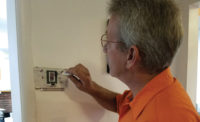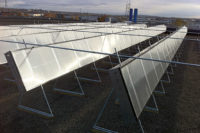Tax Breaks
Renewable tax breaks vary across the nation and are subject to the most recent rules of state and federal tax codes. As such, contractors using tax incentives to assist in the sale of renewable energy products are often advised to keep abreast of changes that may arise from yearly tax code changes.
One type of tax deduction can be paid on a per square foot basis. For example, in Alaska, a tax deduction of $1.80 per square foot is available to owners of new or existing buildings who install interior lighting, building envelope, HVAC, or hot water systems that reduce a building’s total energy and power cost by 50 percent or more in comparison to minimum building requirements set by ASHRAE Standard 90.1-2001.
To qualify, energy savings must be calculated using qualified computer software approved by the Internal Revenue Service (IRS).
In Arizona, there is a corporate tax credit available for 10 percent of the installed cost for solar and wind installations in commercial and industrial applications. The credit, which was established in June 2006, was revised to include all nonresidential entities, including those that are tax exempt. The provisions made in the changes are retroactive to Jan. 1, 2006. The tax credit, which may be applied against corporate or personal taxes, is equal to 10 percent of the installed cost of qualified solar energy devices and applies to taxable years through Dec. 31, 2018.
Loans
Loaning end users the amount of money needed for energy improvements to their property can often come from the local utility companies. In Kansas, for example, Midwest Energy offers its residential and small commercial electricity and natural gas customers in good standing a way to finance energy-efficiency improvements on eligible properties. Under the How$mart on-bill financing program, the utility will pay the initial cost of such energy-efficiency improvements, then recoup the cost through a surcharge on the customer’s bill. The surcharge is designed to never exceed 90 percent of the projected energy savings associated with the improvements. According to the company, the loan program allows customers to make efficiency improvements with no up-front costs. In order to participate in the program, customers must first have an energy audit performed by a Midwest Energy specialist. The audit helps identify cost-effective improvements and encourages the customer to consider completing the work under the guidance of a competent contractor. If a customer participates in the program, the audit is provided free of charge.
Despite its funding problems, Michigan’s “Michigan Saves” state loan program has negotiated financing of up to $150,000 — at a rate as low as 5.9 percent for up to five years — on the upgrade of refrigeration units or HVAC systems and other energy-saving retrofits. The program also offers a special incentive for businesses in the food industry and will provide a 1.99 percent rate for a limited time.
The types of loans and sources from which they are available can be limitless. Economic troubles have an effect on loan standards, but with a little research, contractors may find new loan sources for their customers so that they can continue working on energy-saving, renewable upgrades.
Rebates
Another way for contractors to incentivize their customers is to be aware of, and promote, any local rebates that are being offered. Minnesota is offering its “Made in Minnesota Solar Thermal” rebate program Jan 1, 2014 through Dec. 31, 2023. Rebates of up to 25 percent of installed costs are available, with a $2,500 maximum for residential systems, $5,000 maximum for multifamily residential systems, and $25,000 for commercial systems. Approximately half of the budget will be allocated for solar thermal hot water systems and half will be allocated for solar thermal air projects. The components of the system must be manufactured in Minnesota and the solar thermal system must be Solar Rating & Certification Corp. (SRCC) certified.
In Delaware, instead of offering a loan, one local utility is offering a rebate program. Delaware’s municipal utilities provide incentives for solar photovoltaic (PV), solar thermal, wind, geothermal, and fuel cell systems installed by their electric customers. Eligibility is limited to systems that are intended to supply on-site energy needs. According to the utility, the green energy programs offered by the state’s municipal utilities occasionally vary from city to city.
Renewable Future
When looking at commercial renewable trends, Alan Niles, Western region commercial sales manager, WaterFurnace Intl. Inc., noted that tax breaks, loans, and rebates are likely to be in higher demand to end users as renewable technology continues to grow.
“Tax incentives and energy savings will make renewable energy design necessary for building owners and operators to consider for any current construction or renovation,” he said. “As better computer modeling tools become available, a growing number of professional engineers will provide their customers with a renewable energy option as a matter of standard practice in the not-so-distant future.”
Even though much of 2013 has been a challenging year economically for commercial markets, the most active customer base has a vested interest in energy efficiency and in the economics of a renewable energy component to their system, said Niles.
“Building owners and operators are slowly beginning to realize that they must play an active role in requesting renewable energy options,” said Niles. “Because of the several disciplines whose work is affected — the architect, the mechanical engineer, the electrical engineer, and the civil engineer — there can no longer be the expectation that only the mechanical engineer is consulting on the HVAC system or the design-build contractor can bring a renewable energy option successfully to a project. Commercial contractors should strive to lead this team and give the owner/operator the opportunity to be a part of the process.”
For more information on state-by-state tax breaks, incentives, or rebates, visit www.energy.gov/savings.
Publication date: 9/2/2013
Want more HVAC industry news and information? Join The NEWS on Facebook, Twitter, and LinkedIn today!













